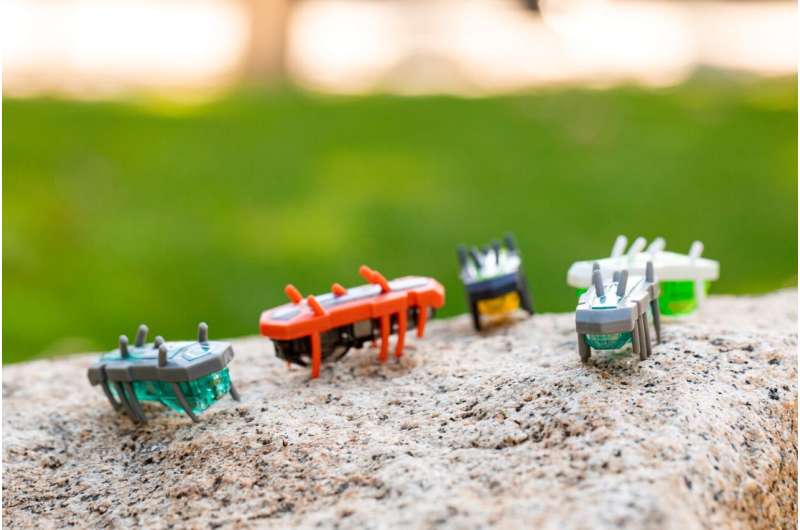Hexbug Nanos used in online lab course to teach undergraduate research skills in physics. Credit: Kristopher Vargas, Pomona College
Although the sudden switch to remote and hybrid learning was seen as an enormous challenge during the COVID-19 pandemic, academic and commercial interest in creative online lab class development has since skyrocketed.
In the American Journal of Physics, researchers from Pomona College in California developed an online undergraduate physics lab course using small robotic bugs called Hexbug Nanos (TM) to engage students in scientific research from their homes.
Hexbug Nanos look like bright-colored beetles with 12 flexible legs that move rapidly in a semi-random manner. This makes collections of Hexbugs ideal models for exploring particle behavior that can be difficult for students to visualize. For the lab course, students used the Hexbugs that were mailed to them, along with a smartphone and common household items.
"We found that the pandemic-inspired reliance on simple, home-built experiments, while de-emphasizing the use of sophisticated equipment, enabled students to more effectively achieve laboratory learning objectives such as designing, implementing, and troubleshooting an experimental apparatus," co-author Janice Hudgings said.
Students first completed a short experiment to investigate the ideal gas law, which describes how pressure, volume, and temperature of a gas are related. They used a rectangular cardboard box divided by a movable wall, made from cardboard and bamboo skewers, that slid along the length of the box.
Varying numbers of Hexbugs were placed on either side of the moving wall to model two gases of different pressures. Students used their smartphones to record the "gas molecules" colliding into the moving wall. Video tracking software was used to obtain the position of the wall as a function of time while it moved until the pressure in the two chambers equalized.
Students then proposed semester-long research projects of their choice, designing experiments using Hexbugs to investigate concepts in statistical mechanics and electrical conduction. One project focused on the Drude model, which uses classical physics to describe the movement of electrons in a metal.
The at-home setup included a long rectangular cardboard box, with 2-inch cardboard rings at fixed locations used to model defects in the metal. Gravity is applied by raising one end of the box relative to the other end. The Hexbug "electrons" are released near the top of the box, randomly scattering from the defects as they are gradually "conducted" down the box due to the gravitational field.
"The Hexbug experiment provides a clearly visible, macroscale model of carrier transport in a wire that is consistent with the Drude model," Hudgings said.
Similar Hexbug experiments could also be useful as online or in-person lab or lecture demonstrations in statistical mechanics, physical chemistry, biophysics, or introductory electromagnetism.
More information: Genevieve DiBari et al, Using Hexbugs (TM) to model gas pressure and electrical conduction: A pandemic-inspired distance lab, American Journal of Physics (2022). DOI: 10.1119/5.0087142
Journal information: American Journal of Physics
Provided by American Institute of Physics
























